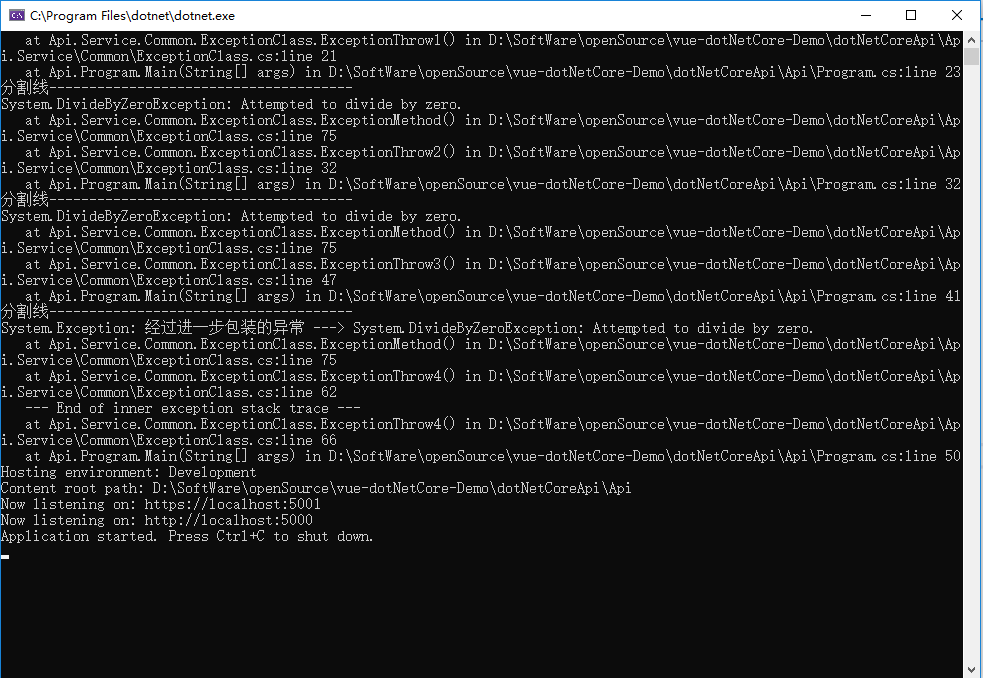之前,在使用异常捕获语句try…catch…throw语句时,一直没太留意几种用法的区别,前几天调试程序时发展找不到异常根源,无意中了解到几种使用方法是有区别的。总结如下:
我们都知道,C#中使用throw和throw ex抛出异常,但二者是有区别的。
在C#中推荐使用throw;来抛出异常;throw ex;会将到现在为止的所有信息清空,认为你catch到的异常已经被处理了,只不过处理过程中又抛出新的异常,从而找不到真正的错误源。
throw new Exception()包装一个异常,把内部异常Exception也抛出,这样抛出的异常是最全面详细的异常。
throw的用法主要有以下几种:
第一种(不推荐使用,可惜很多人都一直这么用的),这样适用会吃掉原始异常点,重置堆栈中的异常起始点:
try
{
}
catch (Exception ex)
{
throw ex;
第二种,可追溯到原始异常点,不过编译器会警告,定义的ex未有使用:
try
{
}
catch (Exception ex)
{
throw;
第三种,不带异常参数的,这个同第二种其实一样,可捕获所有类型的异常,IDE不会告警:
try
{
}
catch
{
throw;
}
第四种:经过对异常重新包装,但是会保留原始异常点信息。推荐使用。
try
{
}
catch (Exception ex)
{
throw new Exception("经过进一步包装的异常", ex);
}
下面举例测试:
1 using System;
2 using System.Collections.Generic;
3 using System.Text;
4
5 namespace Api.Service.Common
6 {
7 public class ExceptionClass
8 {
9 /// <summary>
10 /// 抛出异常方法
11 /// </summary>
12 public void ExceptionThrow1()
13 {
14 try
15 {
16 // 调用原始异常抛出方法来抛出异常
17 this.ExceptionMethod();
18 }
19 catch (Exception ex)
20 {
21 throw ex;
22 }
23 }
24
25 /// <summary>
26 /// 抛出异常方法1
27 /// </summary>
28 public void ExceptionThrow2()
29 {
30 try
31 {
32 this.ExceptionMethod();
33 }
34 catch (Exception ex)
35 {
36 throw;
37 }
38 }
39
40 /// <summary>
41 /// 抛出异常方法2
42 /// </summary>
43 public void ExceptionThrow3()
44 {
45 try
46 {
47 this.ExceptionMethod();
48 }
49 catch
50 {
51 throw;
52 }
53 }
54
55 /// <summary>
56 /// 抛出异常方法3
57 /// </summary>
58 public void ExceptionThrow4()
59 {
60 try
61 {
62 this.ExceptionMethod();
63 }
64 catch (Exception ex)
65 {
66 throw new Exception("经过进一步包装的异常", ex);
67 }
68 }
69
70 /// <summary>
71 /// 原始异常抛出方法
72 /// </summary>
73 private void ExceptionMethod()
74 {
75 throw new DivideByZeroException();
76 }
77 }
78 }
ExceptionClass exceptionClass = new ExceptionClass();
try
{
exceptionClass.ExceptionThrow1();
}
catch (Exception ex)
{
Console.WriteLine(ex.ToString());
}
Console.WriteLine("分割线--------------------------------------");
try
{
exceptionClass.ExceptionThrow2();
}
catch (Exception ex)
{
Console.WriteLine(ex.ToString());
}
Console.WriteLine("分割线--------------------------------------");
try
{
exceptionClass.ExceptionThrow3();
}
catch (Exception ex)
{
Console.WriteLine(ex.ToString());
}
Console.WriteLine("分割线--------------------------------------");
try
{
exceptionClass.ExceptionThrow4();
}
catch (Exception ex)
{
Console.WriteLine(ex.ToString());
}
举例结果:

我们可以明显看出new Exception()自己包装的异常比较详细,能找到异常的跟踪,其次是throw 都可以找到异常源。
throw ex;会把异常吞掉,抛出新的异常,这样会让开发人员找不到异常源。
推荐使用new Excetion()也就是第四种方式。

